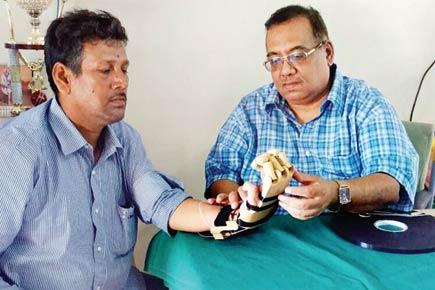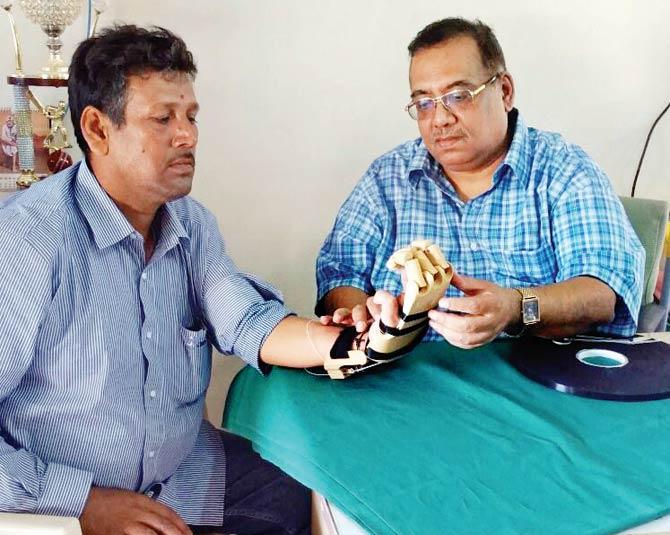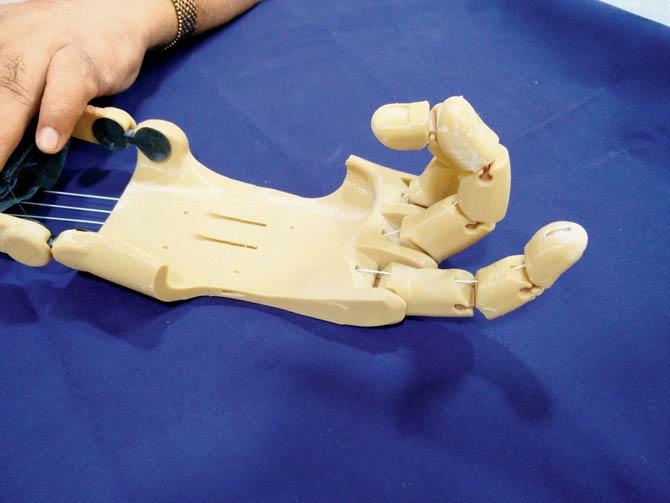Mumbai-based surgeon Dr Mukesh Doshi and Mulund 3D printing firm create an experimental prosthetic for partial amputee Rajesh Ojha who lost fingers in an industrial accident

When 36-year-old Rajesh Ojha, a mechanic, working in industrial plants of Kutchh, lost four fingers of his left hand in August 2015, it was a loss of more than just a means of livelihood. Though prosthetic science has advanced, advancement for partial amputees like Ojha have been few.

Rajesh Ojha with Dr Mukesh Joshi at Kutchh’s Jaya Rehabilitation Centre and Research Institute where he was fitted with the prosthetic
ADVERTISEMENT
On Saturday, however, Ojha was fitted with a prosthetic, which is an experimental venture between a Mumbai-based orthopaedic and a 3D printing firm. The prosthetic, in many ways, is a first for all concerned.

The prosthetic was made by Mulund-based Anatomiz 3D Healthcare which pegs the cost at Rs 18,000
Created out of a biocompatible material, this cost-friendly prosthetic — its creators, the Mulund-based Anatomiz3D Healthcare, peg its cost at Rs 18,000 - took four months to perfect.

Dr Doshi says that the prosthetic comes with strings that are attached to the wrist
After the fitting on Saturday, Dr Mukesh Doshi, a prosthetics and orthotics surgeon, and a consultant at Saifee and Nanavati Hospital, said, “With practice he will be able to hold, throw, write and do all kinds of light work using the hand. The design is actually so simple that it works on strings which are attached to the wrist, as he moves the wrists; he will even be able to close his fingers into a fist,” said Doshi.
An accident and a loss
Ojha said the accident happened while he was at work at an industrial plant in Kutchh. “We were working on anchoring a ship and were then conducting further repair. However, there was a heavy pin which came with an iron base. As soon as I disconnected the pin, my fingers got stuck in the middle of the latchlike structure and I lost all four fingers of my hand as well as half of my thumb,” said Ojha. Though he was rushed to the hospital, his fingers couldn’t be saved. Though he could get a cosmetic silicon prosthesis, it wouldn’t provide movement.
Meanwhile, in Mumbai Dr Doshi was looking for alternatives for patients like Ojha. “Patients who lose an entire palm or a hand were still able to get silicon based prosthesis. However, for those with partial amputation of fingers or amputations ahead of the joint, there were no options available. I was looking for a patient who would be ready to work with us in an experiment to create such a prosthesis,” he said.
Doshi, honorary director of the Kutchh-based Jaya Rehabilitation Centre and Research Institute — where the procedure took place — was informed of Ojha’s case in October. “I had read about Anatomiz3D Healthcare which had previously worked with 3D printing in healthcare and asked them it they’d be able to help. They asked me to send a Plaster of Paris cast of the patient’s hand,” Doshi added. Firoza Kothari, from Anatomiz3D Healthcare, said that while they had previously attempted pre-operative surgical and educational models this was the first time they were venturing into making prosthesis.
“The process worked in four parts: scanning the POP cast, modifying the prosthesis based on the scan of the patient using exact measurements, 3D printing of the parts and then assembling of the same. While the entire process was supposed to be feasible, it actually didn’t work out well the first time,” said Kothari. This was in November.
“The hand was returned to us by the doctor saying the fitting wasn’t right. Twenty days ago, however, Doshi asked for revised designs and we started work,” said Kothari.
She added that while the hand, created out of a Poly Lactic Acid (PLA) material, can be made within five days, it took her team longer as the mold came in from Bhuj.
When asked how the technology works, she said that they work using a 3D printer and hand held scanner. “First we scan the project which is to be printed to get the exact shape of the project and measurement correction. The scanner emits rays which give us a computerised 3D image of the object with cloud points. We make necessary changes and print the objects in parts to be assembled later,” explained Kothari. The material being created from things like cornstarch and sugar have no side effects on the skin and also fits better.
Ojha, who said he was able to pick up a pen on Saturday, said, “I am happy with the hand. I had started working on March 1 and was doing light work. Now, I will be able to do more. This has been a wonderful experiment.”
 Subscribe today by clicking the link and stay updated with the latest news!" Click here!
Subscribe today by clicking the link and stay updated with the latest news!" Click here!







